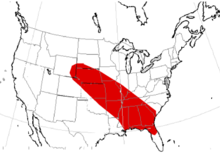- Osbornodon iamonensis
-
Osbornodon iamonensis
Temporal range: Early Oligocene–Early MioceneScientific classification Kingdom: Animalia Phylum: Chordata Class: Mammalia Order: Carnivora Family: Canidae Genus: †Osbornodon Type species †Osbornodon iomonensis 
Approximate range of Osbornodon iamonensis based on fossil distribution Osbornodon iamonensis is an extinct species of bone-crushing Hesperocyoninae, a predecessor of modern dogs that were endemic to North America and which lived from the Orellan age of the Early Oligocene to Early Miocene epoch 23.6—16.3 Ma and existed for approximately 7.3 million years. [1]
O. iamonensis was named by E. H. Sellards in 1916 for Lake Iamonia in northern Florida.
Contents
Taxonomy
Osbornodon iamonensis was named by E. H. Sellards (1916). Its type is FGS 5082. It was recombined as Cynodesmus iamonensis by Simpson (1932), Olsen (1956) and Wilson (1960); it was recombined as Osbornodon iamonensis by Xiaoming Wang (1994), X. Wang and Richard H. Tedford (1996) and Hayes (2000). It was assigned to Mesocyon by Sellards (1916); to Cynodesmus by Simpson (1932), Olsen (1956) and Wilson (1960); and to Osbornodon by Wang (1994), Wang and Tedford (1996) and Hayes (2000).[2][3]
Morphology
Two fossil specimens were examined by Legendre and Roth for body mass.
- Specimen 1 was estimated to have weighed 17.6 kg (39 lb).
- Specimen 2 was estimated to have weighed 16.2 kg (36 lb).[4]
Fossil distribution
- Griscom Plantation Site, northeast Leon County, Florida. ~23.6—18.8 Mya.
- Thomas Farm site in Gilchrist County, Florida. ~21.7 Mya.
- The remaining two specimens were found in the Dry Creek Prospect B Site and Bridgeport Quarries Site of Nebraska. ~20.6—16.3 Mya.
References
- ^ Paleobiology Database: Osbornodon iamonensis Basic info.
- ^ E. H. Sellards. 1916. Fossil vertebrates from Florida: A new Miocene fauna; new Pliocene species; the Pleistocene fauna. Florida State Geological Survey Annual Report 8:79-119
- ^ X. Wang and R. H. Tedford. 1996. in Prothero and Emry
- ^ S. Legendre and C. Roth. 1988. Correlation of carnassial tooth size and body weight in recent carnivores (Mammalia). Historical Biology 1(1):85-98
- R. M. Nowak. 1991. Walker's Mammals of the World. Maryland, Johns Hopkins University Press (edited volume) II (K. Behrensmeyer/K. Behrensmeyer/J. Alroy)
- Wang, X. 2003. New Material of Osbornodon from the Early Hemingfordian of Nebraska and Florida. Bulletin of the American Museum of Natural History, 279:163-176.
Extinct members of the family Canidae †Hesperocyoninae Hesperocyon · Mesocyon · Cynodesmus · Sunkahetanka · Philotrox · Enhydrocyon · Paraenhydrocyon · Osbornodon · Caedocyon · EctopocynusBorophaginae Archaeocyon · Borophagina · Borophagini · Oxetocyon · Otarocyon · Rhizocyon · Cynarctoides · Phlaocyon · Cormocyon · Desmocyon · Metatomarctus · Euoplocyon · Psalidocyon · Microtomarctus · Protomarctus · Tephrocyon · Paracynarctus · Cynarctus · Tomarctus · Aelurodon · Paratomarctus · Carpocyon · Protepicyon · Epicyon · BorophagusCaninae
(extinct genera)Chailicyon · Cynotherium · Dusicyon · Eucyon · Gobicyon · Leptocyon · Neocynodesmus · Nurocyon · Prototocyon · Theriodictis · XenocyonCaninae
(extinct species and subspecies)Canis apolloniensis · Canis armbrusteri · Canis cedazoensis · Canis dirus · Canis edwardii · Canis ferox · Canis lepophagus · Canis lupus hattai · Canis lupus hodophilax · Urocyon progressusCategoryThis article related to prehistoric animals from order Carnivora is a stub. You can help Wikipedia by expanding it.
